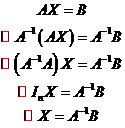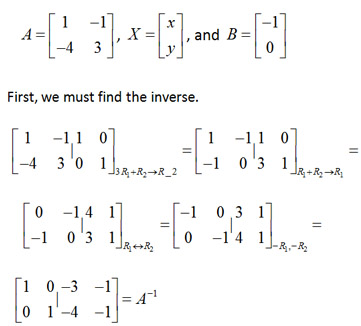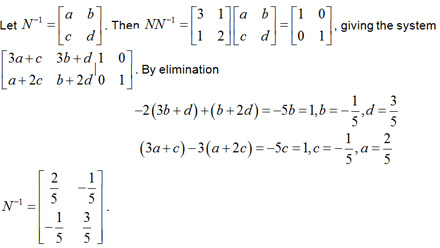Let A be an n*n matrix. An n*n matrix A-1 such that
AA-1=A-1A=In
is the inverse of A. A matrix A is nonsingular if A-1 exists (i.e., if A has an inverse). If a matrix does not have an inverse, then it is singular.
Examples Explanation

Calculating The Inverse
Given a square matrix M, we know the size of its inverse (the same size as M) and the product of M and its inverse. Using this information, the inverse of M can be calculated by assigning variables to the elements of M -1 and representing the product MM -1 as a system of n equations in n unknowns, where M has dimension n*n
Examples

Explanation


This system can be expressed as an augmented matrix. Recall that an augmented matrix includes the constant coefficients of a system of equations.

The solution to this system will provide the elements of M -1.
Solving Systems of Equations with The Matrix Inverse
Systems of linear equations can be solved using the matrix inverse. The system must be represented by the equation
AX=B
where A is the coefficient matrix of the system, X is the column matrix of variables, and B is the column matrix of constant coefficients. The solution to the system will then be A -1B because

Examples

Explanation


The solution is (x,y)=(3,4)
Try these exercises
Solve

Show that


Show that the inverse of M is


Show that

Find the inverse of N using a system of four equations in four unknowns.
- Is the identity matrix singular or nonsingular?
- Solve the system

using elementary row operations and matrix inverses.
- Solve the system

using elementary row orations and matrix inverses.
- Solve the system

using elementary row operations and matrix inverses.
- Is it possible to solve a system composed of less unknowns than equations using elementary row operations and the matrix inverse?
Answers to questions






By substitution,











No elementary row operations are required to transform In into In, so In-1=In. Since In has an inverse, it is nonsingular.








- Yes, but the extraneous equations must be eliminated so that the coefficient matrix is square (having the same number of equations as unknowns).